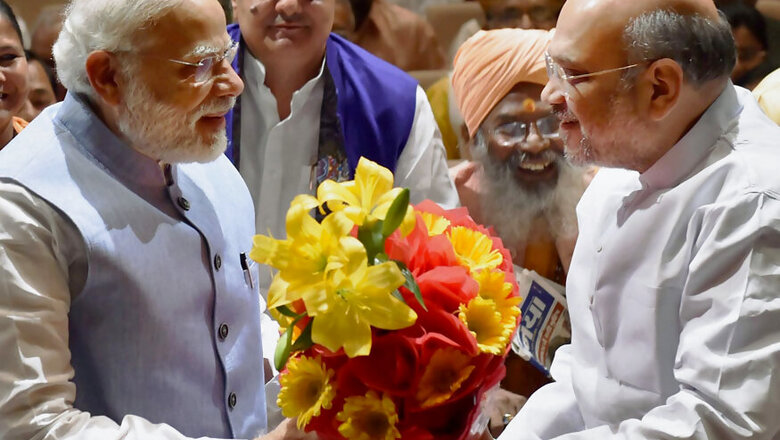
views
 Former state minister and Bareilly strongman Dharampal Singh had already started getting congratulatory messages from his supporters. After Kalyan Singh, he would have been the first Lodha-Rajput president of the BJP in Uttar Pradesh.
Former state minister and Bareilly strongman Dharampal Singh had already started getting congratulatory messages from his supporters. After Kalyan Singh, he would have been the first Lodha-Rajput president of the BJP in Uttar Pradesh.
Dharampal, a protege of Rajnath Singh had patiently waited for his turn all these years.
With party again attempting to chisel out OBC-upper caste combination for 2017 Assembly polls, Dharampal fitted the bill to the tee.
By the first week of April 2016, BJP central leadership had narrowed down its choice of state president to three - and Dharampal was the obvious front runner. The other two names in contention also belonged to backward communities: Swatantra Dev Singh, a Kurmi leader from Orai in Bundelkhand; and a little-known first-time MP from Phoolpur, Keshav Prasad Maurya.
While the discussions were on, a senior pracharak from West UP argued before RSS joint-general secretary Krishna Gopal of nominating an MBC or Most Backward Caste state president. The pracharak posited that socially well off non-Yadav OBCs like Kurmis and Lodhas are already with the BJP. The party needs to top the combination up with something more.
Dharampal’s celebrations turned out to be very short-lived indeed. On RSS recommendation, Maurya from the VHP stock was appointed as the UP BJP president at the last minute by Amit Shah.
It was a time when Shah had faced two consecutive defeats in Delhi and Bihar. Uttar Pradesh was the next big test. His presidency was coming up for renewal in another six months. Union government had completed two-and-a-half years in office. Assam elections were lined up next. Overall, it wasn’t a very comfortable situation.
“His biggest strength is he knows when to concede and how much to concede. And when to play the hardball," says a BJP functionary mulling over the turnaround in party’s fortunes in UP.
“And most importantly, he has displayed that immense tenacity to work his way around impediments and use the situation to his advantage."
In the run-up to the UP polls, the party was in no mood to concede to demands from a dozen BJP leaders seeking ticket for their children. The election at that point was precariously poised and Shah did not want to take any chances. BJP, finally, decided to accommodate one and all- from Rajnath’s son in Noida to Om Prakash Singh’s son in Chunar.
*****
Election Commission was slated to announce poll dates for UP elections. Samajwadi Party General Secretary Ram Gopal Yadav was concerned about just one aspect of the schedule.
From his decades of experience in the state politics, Yadav knew all too well the impact of sequencing of elections in multi-phased polls. West to East elections suit BJP. Conversely, East to West polls are more conducive to SP - as was the case in 2012 when the first phase of polling took place in SP stronghold in Poorvanchal.
That was also Shah’s concerns when he took over the reins of UP in 2013 as general secretary in Rajnath Singh’s team. It was the first time he was managing elections outside Gujarat- and a mammoth state like UP at that, but he understood the nuances.
“When the election dates were announced he only wanted to know one thing. Whether it was a west to east or east to west polls,” said an associate who has worked with Shah in the past.
By some quirk of fate, on both occasions in 2014 and 2017, western UP has polled first.
In one year that he had got to figure out UP in the run-up to the general elections in 2014, Shah had figured out the complex matrix of UP’s diverse demography.
The knowledge then acquired helped immensely in two and half years later when he planned, strategised and executed BJP’s victory in 2017.
************
Sunil Bansal gingerly poured warm milk over a bowl of corn-flakes and adds half-a-teaspoon of sugar in a two-room set on the first floor of the BJP office right opposite Vidhan Sabha in Lucknow.
This has been Bansal’s office-cum-residence for the last two-three years.
The RSS pracharak from the ABVP stock has been a close associate of Amit Shah since the 2014 general elections. One corner of the small room is occupied by an elliptical exercising machine. On the opposite wall is a picture of a Bansal with Shah.
It is half past eight on March 11, and trends from the postal ballot count had started to coming in.
“My experience during Bihar elections came in quite handy this time around,” said Bansal, the general secretary organisation of the state BJP.
His travel to Bihar was cut short due to a bout of typhoid, but a glimpse of Bihar campaign in many ways was an eye opener for Bansal.
First, it was decided by the party to spruce up the organisation, especially the election machinery to avoid a Bihar redux. As a part of massive organisational expansion exercise, election committees for more than 1.37 lakh booths were set up. In the process, BJP could engage more than 13 lac workers, especially youth with the party.
“The idea was to create the right sort of infrastructure at the grass-roots for the political leadership to capitalise on,” says a BJP member closely associated with the campaign.
The online membership campaign last year yielded maximum response from UP. About 2.3 crore new members enrolled in the month-long process.
At the end of this drive, the party was in procession of a huge data base comprising the name, constituency, booth number and phone numbers of at least 1.8 crore new members.
*********
Amit Shah as a strategist either wins big or loses big. For the outcome of the entire campaign that he manages rests entirely on the efficacy of the strategy woven to mobilise electorate.
In Bihar, team Shah learnt many lessons. They realised and admitted what and where it went wrong and then made amends.
“He’s the most objective politician I have worked with,” an associate said.
“The ideological difference with an adversary or the intended outcome of an electoral battle does not in any way impinge upon his capacity to gauge the opponent. Shah assesses strength and weakness of his opponent without bias," he added.
In Bihar, the premise to build a social coalition between upper castes and Dalits was conceptually flawed. First, Bihar unlike UP has fewer upper castes, almost 40 percent less. Second, BJP made the cardinal mistake of attempting to woo the Yadavs to its fold without realising practical difficulties in sneaking past Lalu Yadav - a powerful OBC satrap with strong and proven Mandal credentials.
Lastly, unlike in UP, the mahagathbandhan had a non-Yadav OBC leader in Nitish Kumar leading the pack as credible and tested CM candidate.
Thus, in Bihar BJP was squeezed out in a pincer attack - Lalu wielding his caste and Nitish his development plank.
In Uttar Pradesh, BJP made amends. It fielded only a dozen Yadav candidates. Instead, it relied heavily on non-Yadav OBCs giving 130 tickets to this amorphous group of small castes which together make up almost 30 percent of the electorate.
In the last one year, BJP imported many such candidates, both from SP and BSP. For instance, Dara Singh Chauhan, the former leader of the BSP in LS was inducted and made backwards morcha president. Chauhan comes from MBC Nenua-Chauhan community concentrated in four Assembly segments in and around Mau.
In western UP, former SP MP S P Singh Baghel, won from his Assembly constituency in Firozabad. Baghel comes from nomadic shepherd MBC sub-caste. The upper caste which constitute a bit more than twenty percent of the electorate in UP presented a perfect launching pad for the BJP to capitalise on non-Yadav OBC mobilisation.
“In UP both Mayawati and Akhilesh left a lot of space for the BJP. No one was wooing MBC voters. It was there for the taking,” a party leader said.
Jugal Kishore, a former BSP MP and once a close associate of Mayawati and Kanshi Ram, joined BJP last year. Kishore was once the powerful BSP coordinator for the entire Poorvanchal region. Now, his son won on a BJP ticket from Lakhimpur Kheri by a margin of more than 40,000 votes. One hundred and thirteen out of 115 imports contesting on BJP ticket won the elections.
“The non-Yadav OBCs which earlier stood by the BSP migrated substantially to BJP this time around,” he said.
“Of the 23% BSP has mopped up, 17 percent was core Jatav vote. About four percent were from Muslim voters and the rest two percent was candidate vote,” Kishore added.
“Unlike the popular image, Shah as a student of politics is quick to understand the idiom of politics in a particular state. He has much wider view and perspective of things,” said a party worker closely associated with him during Lok Sabha polls.
“For example, he once observed that one of the greatest achievements of BSP as a social movement was its ability to act as a safety valve against the spread of Naxal activities from neighbouring Bihar,” he added.
The BJP’s strategy for UP elections was hinged on the meltdown of the BSP and division of minority votes. On both accounts, Shah was impeccable, in timing and execution.
*********
The first two phases in western UP had the maximum concentration of minority votes - ranging from 20 to 50 percent. Minorities along with Dalits in districts like Bijnor and Saharanpur at places constitute 60 percent of the electorate.
In the first two phases, BJP made two tactical moves as a part of the larger game plan. Since BSP with a substantial Dalit vote could have been the main challenger for the party here, BJP leaders in their speeches projected SP as its main adversary. The ideas were to confuse the minority votes.
Second, and perhaps most importantly, the party leaders were asked to refrain from attempts to polarise election in West UP and Rohilkhand.
The logic was simple: any counter-polarisation towards either SP or BSP in high Muslim concentration districts had the potential to damage BJP in many Assembly segments.
The results indicate how this strategy worked perfectly well on the ground. Most of the SP MLAs from the minority community won in this region.
It was very close to the third and the fourth phase that Kabristan-Shamshan and Kasab entered the electoral lexicon of the BJP leaders.
“In areas where Muslims are lesser in numbers, Hindu polarisation suits the BJP for minorities are numerically less to affect the outcome,” a BJP worker associated with the campaign said.
“Our only worry was the fifth phase. In the Devipatan division, the Terai region of UP bordering Nepal there are pockets of high Muslim populations,” he added.
But by then the general confusion among the minorities had spread far and wide. BJP leaders started targeting BSP in their speeches as SP was the main rival in the area.
“After the third phase, when we had encouraging reports from Yadav heartland of Etawah and Central UP we knew we were winning,” another associate said.
In Allahabad, thus, Shah and team decided to capitalise on the gains and go for the kill.
“The idea to hold a road show in Allahabad and Gorakhpur emanated from our feedback,” a BJP leader privy to the strategy said.
Similarly, the media misunderstood PM’s three-day back-to-back campaign in Varanasi in the last phase.
“Why would anyone put so much at stake if one were losing?” the leader said.
Even when the loudspeakers went silent after the end of the campaign, there was further work do be done by Shah and his associates.
For instance, canvassing for the seventh and the last phase of polling ended dot at 5 pm on the 6th of March. But late in the evening, a senior party functionary campaign in Varanasi made a telephone call to all those spearheading the campaign in forty Assembly segments going to the polls the day after.
The party had identified more than a thousand booths where BJP’s vote share had not dropped between 2012 and 2014 elections.
“One could infer from the data that these were the favourable catchment area for us,” a worker in Varanasi said after the counting.
All the possible resources were made available to these booth committees to increase the polling in their respective booths by 100 to 200 votes. That’s almost 5000 extra votes in each constituency. In a close election, it could be the difference between winning and losing a seat.
******
Amit Shah, in his politics, is as aggressive as it gets. But in his personal life and habits, he is a pure Jain. Two large pictures of Savarkar and Chanakya don the walls of his living room at his residence in Delhi. That’s probably his inspiration in politics.
He has his dinner early in the evening. That’s his habit. But he works late into the night, sometimes well into the morning, ringing people up after the campaigning for the day has ended. That is his politics.
“But amidst all this, his biggest asset is his ability to grow under Modi. Bargad ke neeche grow karna asaan nahin hai. The only other person who could do it well was Anadiben,” said a person who worked with him in 2014 elections.
His next target is Karnataka. Apart from Punjab, it is now the only other big state where Congress is in power. Veteran Congress leader and former state CM SM Krishna will be joining BJP soon. It is a work in progress.
“Krishna or any other congress leader joining BJP which was an un-touchable a few years ago has a long term implication,” a BJP functionary said.
“You are taking away not only Krishna but 40 years of Krishna’s political legacy away from the Congress. Congress will never be able to own Krishna. Only a party which in the formative years had to appropriate icons from the Congress- like Sardar Patel- can understand this,” he added.
With UP firmly under the belt, at the BJP parliamentary party meet earlier this week Shah’s message for the party MPs was clear- plan and work for 2019.
He’s himself doing that. To make up for any losses elsewhere, the focus is clearly on 100-odd seats in West Bengal, Orissa and Tamil Nadu where BJP has had little or no political footprint.
And very quietly, Amit Shah is reading up these days and attempting to understand the political idiom of these three states. The strategy will follow and follow soon.(More Sunday Features)

















Comments
0 comment